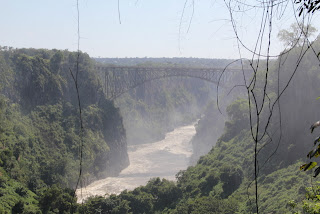.JPG) Mosi oa Tunya (more commonly known as Victoria Falls in the English speaking world) is a 1,708 meter wide (5,604 feet) and 108 metre high (354 feet) waterfall of the Zambezi River. The portion you see in the picture is that of the Eastern Cataract on the Zambian side of the falls (the falls are shared between Zambia and Zimbabwe). For the past 100,000 years it has been cutting its way upriver through sandstone cracks in the harder basalt plateau over which the river runs. There are 6 gorges downstream from the current falls each of which at one time were the face of the waterfall.
Mosi oa Tunya (more commonly known as Victoria Falls in the English speaking world) is a 1,708 meter wide (5,604 feet) and 108 metre high (354 feet) waterfall of the Zambezi River. The portion you see in the picture is that of the Eastern Cataract on the Zambian side of the falls (the falls are shared between Zambia and Zimbabwe). For the past 100,000 years it has been cutting its way upriver through sandstone cracks in the harder basalt plateau over which the river runs. There are 6 gorges downstream from the current falls each of which at one time were the face of the waterfall. The flow varies significantly depending on the season and the amount of rainfall upstream. When it is high, as it was this time, one could only see a small part of the falls. Mostly it was a thunderous roar and mist that came down as a heavy rainfall. In high season some 500 million litres of water per minute thunders down the cataracts. The mist rises to 500 meters and can be seen up to 50km away. An yet - in the dry season one can walk at the top of the falls all the way to Livingstone island.
The flow varies significantly depending on the season and the amount of rainfall upstream. When it is high, as it was this time, one could only see a small part of the falls. Mostly it was a thunderous roar and mist that came down as a heavy rainfall. In high season some 500 million litres of water per minute thunders down the cataracts. The mist rises to 500 meters and can be seen up to 50km away. An yet - in the dry season one can walk at the top of the falls all the way to Livingstone island.
.JPG) The Zambian town of Livingstone lies about 10 km to the north of the Falls. We found a lovely bed and breakfast there to rest and refresh ourselves before heading north to visit MCC partners, projects and personnel. I always leave Mosi oa Tunya humbled in spirit and impressed by the resounding power and at the same time incremental movement of natural forces as they shape and reshape the world in which we live, and on which we depend for our very survival.
The Zambian town of Livingstone lies about 10 km to the north of the Falls. We found a lovely bed and breakfast there to rest and refresh ourselves before heading north to visit MCC partners, projects and personnel. I always leave Mosi oa Tunya humbled in spirit and impressed by the resounding power and at the same time incremental movement of natural forces as they shape and reshape the world in which we live, and on which we depend for our very survival.
No comments:
Post a Comment